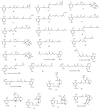Diversified Chemical Structures and Bioactivities of the Chemical Constituents Found in the Brown Algae Family Sargassaceae
- PMID: 38393030
- PMCID: PMC10890103
- DOI: 10.3390/md22020059
Diversified Chemical Structures and Bioactivities of the Chemical Constituents Found in the Brown Algae Family Sargassaceae
Abstract
Sargassaceae, the most abundant family in Fucales, was recently formed through the merging of the two former families Sargassaceae and Cystoseiraceae. It is widely distributed in the world's oceans, notably in tropical coastal regions, with the exception of the coasts of Antarctica and South America. Numerous bioactivities have been discovered through investigations of the chemical diversity of the Sargassaceae family. The secondary metabolites with unique structures found in this family have been classified as terpenoids, phlorotannins, and steroids, among others. These compounds have exhibited potent pharmacological activities. This review describes the new discovered compounds from Sargassaceae species and their associated bioactivities, citing 136 references covering from March 1975 to August 2023.
Keywords: Fucales; Sargassaceae; bioactivity; brown algae; secondary metabolites.
Conflict of interest statement
The authors declare no conflicts of interest.
Figures


























References
-
- Kumari P., Kumar M., Gupta V., Reddy C.R.K., Jha B. Tropical marine macroalgae as potential sources of nutritionally important PUFAs. Food Chem. 2010;120:749–757. doi: 10.1016/j.foodchem.2009.11.006. - DOI
-
- Anis M., Ahmed S., Hasan M.M. Algae as nutrition, medicine and cosmetic: The forgotten history, present status and future trends. World J. Pharm. Sci. 2017;6:1934–1959.
-
- Muñoz J., Culioli G., Köck M. Linear Diterpenes from the Marine Brown Alga Bifurcaria bifurcata: A chemical perspective. Phytochem. Rev. 2013;12:407–424. doi: 10.1007/s11101-012-9246-4. - DOI
-
- Remya R.R., Samrot A.V., Kumar S.S., Mohanavel V., Karthick A., Chinnaiyan V.K., Umapathy D., Muhibbullah M. Bioactive potential of brown algae. Adsorpt. Sci. Technol. 2022;2022:1–13. doi: 10.1155/2022/9104835. - DOI
Publication types
MeSH terms
LinkOut - more resources
Full Text Sources

